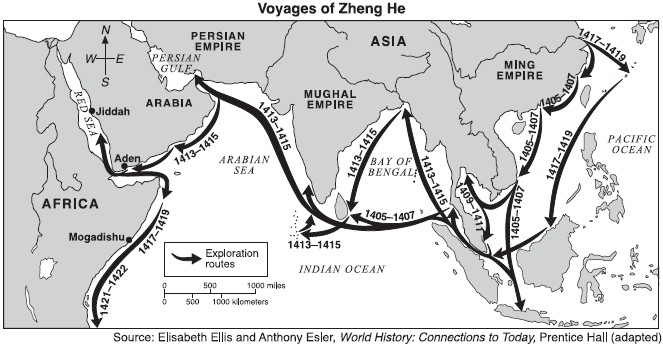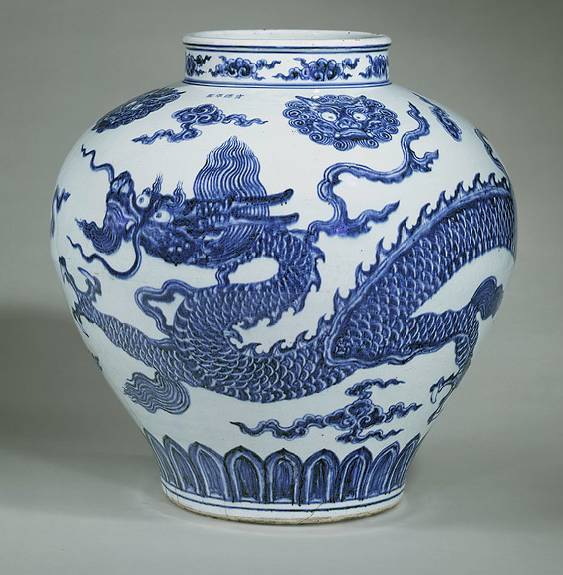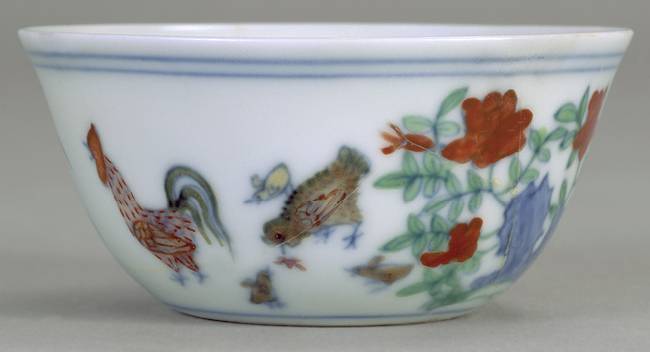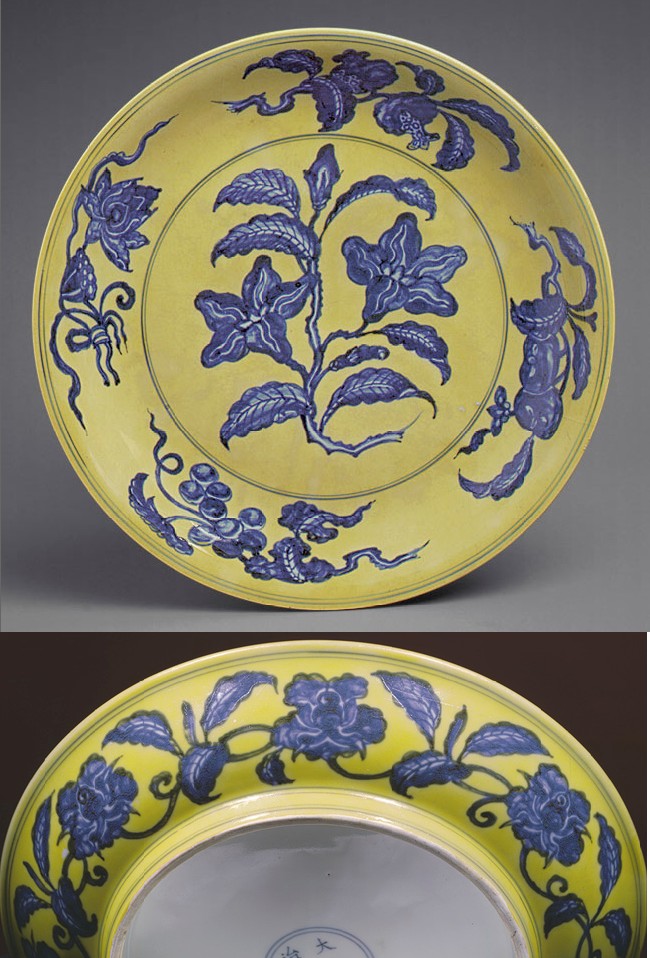 Back to Gotheborg.com Home Page
Back to Gotheborg.com Home Page
Copyright © Jan-Erik Nilsson, Gothenburg, Sweden 1998-2023

The early Ming dynasty was a period of cultural restoration and expansion. The reestablishment of an indigenous Chinese ruling house led to the imposition of court-dictated styles in the arts. Painters recruited by the Ming court were instructed to return to the styles of the earlier Southern Song (1127–1279) Imperial Painting Academy. Large-scale landscapes, flower-and-bird compositions, and figural narratives were favored as images that would glorify the new dynasty.
The Jingdezhen kilns suffered a temporary decline during the transition from the Yuan to Ming Dynasty. There is no consensus on the date when the official kiln was established in Jingdezhen. Two conflicting dates were mentioned in ancient texts. One put it as A.D 1369 and the other A.D 1402 (which would be 4th year of Ming Jianwen). However, in the 1990s numerous shards including those of large blue and white and copper red chargers, copper red larger ewers, big bowls and jars were recovered from the ancient official kiln site in Zhusan. It confirmed porcelain production for the palace was substantial and that the Hongwu official kiln probably came into operation at a date earlier than 1402 A.D.
Blue and white continued to be produced during the Hongwu period for the imperial palace. As compared with those of the Yuan period, the design has evolved with some stylistic differences. The motifs are more sparsely laid out. The depiction of the floral motif became more stiff and lacked the vitality of their Yuan counterparts. The variety of the motif has also became more limited. Human and mystical animals such as the chilin were no longer produced. The most commonly used motifs are floral scrolls, dragon, phoenix, garden scene, 3 friends of winter (pine, bamboo and prunus) motif. Large chargers with diameter of at least 45 cm continued to be produced. The outer base is not glazed and the paste usually oxidized into a orange color.
Somehow, the potters has also lost the ability to produced the vibrant blue color despite scientific tests that confirmed similar imported cobalt was used to draw the motif. The supply of imported cobalt was cut off when subsequently Hongwu imposed the foreign trade ban. So far, no evidence is available to show that local cobalt was replaced to continue producing blue and white for the Imperial palace. Some Chinese ceramics experts are even of the view that local cobalt was only used for minyao (folk kiln) blue and white later than Hongwu period. To find out more regarding the basis of their argument, please read this article.
An interesting development of Hongwu period was large number of wares with underglaze copper red decoration being produced. With dwindling supply of imported cobalt, the potters may have been forced to use copper oxide although it is a difficult material to control. It is unstable and volatile. Many finished products has blackish purple or very pale gray purplish red instead. It is difficult to find a piece with the desire shade of red.
The Chinese potters has a long established tradition of using iron oxide to produced brown/black underglaze decoration. It is a much more easy material to control compare with copper oxide. Why this has not been selected as a substitute for cobalt oxide? It may have been due to the Emperor's preference for red. Interestingly, there was a find of a dish decorated with overglaze iron-red enameled dragon motif within ruin of the Nanjing palace.
During this period, monochrome such as white, black and red glaze were also produced. But there are very few extant pieces.
Private kilns
The reestablishment of an indigenous Chinese ruling house led to the imposition of court-dictated styles in the arts. For porcelain made at the private kilns, a relatively high degree of control was imposed. For example, during the reign of Hongwu, a decree was issued in the year 1371 which forbid certain subjects such as previous emperors, queens, sages or saints, dragon, phoenix, lion and chilin on porcelains. During the Hongwu period, there were many instances of capital punishment for infringement of these policies. For example, one artist was executed because he painted a celestial being riding a dragon. That was deemed a grave offense since the dragon was a symbol of the emperor.
Hence, Hongwu imperial blue and white have only motifs which are limited in scope. They consisted mostly of various types of ornaments and flowers. There were none with human subjects. The composition and style of the decoration still show influence of Yuan blue and white.
During the reign of Yongle, the use of reign mark on vessels was first introduced The archaic form of 4 characters "Yongle Nianzhi mark" mark is either impressed, incised or written in underglaze blue and white. The only known blue and white examples were found in cups (dia. 9.3 cm) called yashou bei in Chinese. The four characters are on the inner base within a flower or embroidered ball and two lions. The incised/impressed reign mark is found in some white or monochrome red cups/stem cups. Majority of the vessels however still did not bear any reign mark.
Yongle emperor favored white wares. During his reign, a refined sugary white glaze called tianbai was widely produced. It was an improvement over the shufu white glaze produced during the Yuan dynasty. The jade-like glaze has a smooth texture. Many of the tianbai vessels have finely incised/impressed motif. For example, on monk's hat jug, there are some with finely incised floral scrolls top with Buddhist precious objects. The white tianbai vessels were mainly used for Buddhist ritual ceremony.
Another significant development was the phasing out of large complicated jars and vases with lugs popular during the Yuan period. Majority of the vessels medium and smaller in size. The form is more simple and graceful Some notable newly introduced shapes are the tankard, flat moon-shape vase and flat rim basins. However, the potters were also capable of producing technical difficult items such as large chargers with a diameter of more than 60 cm.

In July 1405, the first of seven expeditions set sail, over 50 years before Columbus' voyage to the New World. The fleet included 27,870 men on 317 ships. Between 1405 and 1433, the Ming government sponsored a series of seven naval expeditions. They were designed to establish a Chinese presence, impose imperial control over trade, and impress foreign peoples in the Indian Ocean basin.
During the reign of Yongle, admiral Zhenghe, kown as Sanbao (Three Jewels), sent out magnificent fleets on diplomatic trips to Southeast Asia, India and reached as far as East Africa. Imported cobalt called sumali qin was brought back during the trips. This enabled the production of imperial blue and white to resume. Compared with Hongwu blue and white, the motifs of those on Yongle vessels are even more sparsely laid out. Visually, the larger white space set off the motifs. There are also more variety of floral sprays and fruits introduced as decorative motifs. Human subject such as the middle eastern looking dancer and infants in garden were found in extant examples. The paste of vessels of this period is refined and smooth. The glaze is smooth, thick and glossy. The blue is brilliant with certain areas displaying the heap and piles effect. However, the cobalt along the outline of the motifs tends to diffuse into the glaze and hence the motif appears fuzzy and less well defined.
There was also further improvement in the use of copper red for decoration. An interesting new product was stem cup with decoration of three fishes in red on white ground. There are also monochrome red bowls and saucers incised with dragon and cloud motif.
An interesting discovery was a pear shaped ewer excavated in Zhusan in Jingdezhen. It was decorated with incised dragon covered with green enamel and yellow ground. It was a fore-runner of those vessels (mainly saucers and bowls) decorated with similar decorative technique and previously thought to originate during the Chenghua period.

Jar, Ming dynasty, Xuande mark and period (1426–1435)
Underglaze blue and white decoration of a Dragon. Height 19 in. (48.3 cm)
During Xuande period, reign mark became a common feature on the imperial wares. It is either in 6 characters standard script "Da ming Xuande Nianzhi" 大明宣德年製 or 4 characters "Xuande Nianzhi". There were also rare examples with 4 characters archaic script. The location of the written mark varies: such as on the outer base, rim, shoulder, spout or handle and etc. The reign of Xuande is a short 10 year duration. But the quantity of vessels produced was huge. For example, in the Ming official record "Da Ming Hui Dian", it was mentioned that in the 8th year of Xuande (1433 A.D), the palace ordered the official kiln in Jingdezhen to produce 443,500 vessels with dragon and phoenix design.
The variety of motifs was numerous. Besides the ever popular floral scrolls and floral sprays, there were also many varieties of dragon and phoenix design. The dragon of Yongle/Xuande is strong and ferocious looking, symbolic of the power of the empire. Buddhist precious objects and sanskrit/tibetan characters were also commonly used as part of the design on vessels. There was also more depiction of animal motif such as lions and human related subjects including ladies or infants in garden. Some of the blue and white vessels also has part of the motif incised. For example, the dragon having a blue and white outline but with the scale incised. A new product of the period was underglaze floral decoration with yellow ground.
The glaze on Xuande vessels is usually slightly uneven with an orange peel effect.
In the Xuande period, the potters were able to produce consistently brilliant copper red. The monochrome copper red of Xuande is highly prized. Another common technique involved incising the dragon motif on the biscuit and subsequently filling the motif with the copper oxide enamel before glazing and firing. After firing the incised outline of the motif appeared in a deeper red. Other well known examples on bowls and stem cups are red glaze with decoration of the fish in silhouette or fish or peach in copper red on a white ground. There are also rare examples of underglaze copper red combined with cobalt blue dragon motif.
There are also examples of low relief and finely incised floral motif in white on a cobalt blue or iron brown ground. Monochrome in imitation of ancient famous ceramics such as celadon, Ru and Ge glaze were also produced.
Another important product of Xuande period was underglaze blue and white combined with overglaze enameled motif. An example of a dish with mandarin ducks in lotus pond was recovered from the ancient official kiln site. In the Xuande dish, the outline of the motif is mainly incised and partly drawn in underglaze cobalt blue. The space within the outline was then applied with overglaze enamels. Some ceramic experts accepts this as doucai while others prefer to call it wucai (ie 5 colors with blue treated as a color. It should be noted that wucai does not mean strictly 5 colors are used. It can be less or more than 5). Why the inconsistency in the definition? For the 'purist', doucai must strictly meet the criteria of underglaze blue outline of motif with the area within applied with overglaze enamels. To them, the Xuande dish is not fully outlined in blue and hence does not meet the criteria.
More importantly, the use of underglaze blue and overglaze enamels for decoration of motif was an innovation. There is an extant stem bowl with such decorative motif in Sakya monastery in Tibet.
No example of imperial ware with reign mark was found during this duration commonly termed interregnum period. This was a period of political unrest. Zhengtong emperor was captured by the Mongolian forces. His brother was enthroned as emperor Jingtai. The mongols released him and subsequently he plotted to remove Jingtai and regained the throne. Based on official records, the official kiln did not cease production but production was on a much reduced scale. The absence of reign mark however make the identification of vessels made by the official kiln problematic. It appeared that at least part of the palace use of porcelains was met by commercial kilns. For example in Ming shilu (Veritable records of the Ming Dynasty), it was mentioned that in the 1st year of Zhengtong, 50,000 pieces of porcelains produced in commercial kilns was presented as tribute by a Fouliang official named Lu Zishun.
One of the most famous motif of this period depicts human in a pavilion with scrolled clouds and mountain in the background. They are usually drawn on meiping and big jars. Despite the high quality, they were most likely products of commercial kilns. So far, the only known published examples of official kiln porcelains of Zhengtong period was excavated fragments of huge pots (more than 60 cm in diameter) with dragon motif.
In the initial years, the motifs on the vessels produced were essentially a continuation of those found since Xuande period. Many still used imported cobalt. But in the later years, production focused on mainly small thinly potted vessels which are highly elegant and delicate looking. The glaze is purer and highly glossy. This is typified by the palace bowl with floral scrolls The whole motif is executed in fine lines and completed with thin wash of blue. The cobalt used was a local cobalt called "pingdeng (potang) qing", mined in Jiangxi. It is paler and when applied as a wash over motif, the blue is more even. Decorative motifs using this cobalt blue include phoenix, dragon, children playing, 3 friends of winter, Tibetan/sanskrit inscription, vajra and etc. The six characters reign mark 'Da Ming Chenghua Nianzhi' is either enclosed within a circle or square. There are also jars without reign mark but with a character 'tian', ie heaven written instead.

Cup, Ming dynasty, Chenghua mark and period (1465–1487)
Porcelain painted in "doucai" underglaze blue and overglaze enamel decoration. Diam. 3 1/4 in. (8.3 cm)
But if there is one product that represented the highest standard of craftsmanship in Chenghua period and rightly considered as one of the peaks of excellence in the history of Chinese porcelain, it must be the doucai porcelain. During the Wanli period, a pair of doucai cups with chicken motif was said to be worth 100,000 taels of silver. The motif is first outlined in cobalt blue, glazed and fired. The space within the outline is then filled with overglaze enamels, such as light green, yellow, purple and red enamels. The enamels are fixed by a second firing at a lower temperature. Some well known decorative motifs includes floral spray/birds, grapes and vines, chickens in landscape and human subject. Usually, they are depicted on exquisitely made small vessels including stem cups, small vases and cups.
It is possible that the patronage of the emperor's favorite, Wan Gufei, was responsible for the promotion of several decorative techniques at the Jingdezhen kilns. Premier among these is the fabled Chenghua doucai ("contrasting colors" or "contending colors"), which is a combination of two ornamental processes. In doucai decoration, designs were completely outlined in cobalt blue on the unfired vessel, and a few areas of blue wash were painted in as well. After glazing and the usual high-temperature firing, the outlines were filled in with overglaze red, green, yellow, and aubergine enamels that were then fired at low temperatures. Doucai-style enameling was usually reserved for intimate objects of exquisite refinement, and the rare examples of Chenghua date are some of the most highly treasured of all Ming-dynasty porcelains.
Excavations in Zhushan revealed that Chenghua period continued to use a wide variety of decorative techniques of the earlier reign. For example, copper red fishes with white ground, incised dragon covered with green enamel and yellow ground, incised dragon covered with aubergine enamel and yellow grounds, overglaze iron red motif, blue and white floral motif with yellow ground, imitation of Longquan celadon and ge type glaze, susancai and etc. From Chenghua onwards, vessels with monochrome red or decoration with underglaze copper red became rare.
The imperial porcelains produced during the Hongzhi and Zhengde period essentially continued to use decorative techniques of Chengua period. Hongzhi is a frugal emperor who is able to empathies with the sufferings of the people. During his reign, officials records showed that he issued edict on several occasions to reduce production in the official kilns. The main type of porcelain produced were blue and white.

Dish, Ming dynasty, Hongzhi mark and period (1488–1505), MET, NY.
Yellow enamels and undeglaze blue decoration. The dish belongs to a series of rather heavily potted dishes with this decoration that originated in the Xuande period (1426–35) and continued to be produced until at least the Jiajing reign (1522–66). It is generally assumed that the Xuande pieces was an original order, and that the dishes from subsequent reigns were manufactured as replacements for dishes that had been broken.
Hongzhi period is most noted for its beautiful yellow enameled ground dishes with underglaze blue decoration. Their quality are superior as compared with similar type produced since Xuande period and after Hongzhi period. Some other more commonly used decorative technique include those with incised dragon either left in biscuit form or painted with green enamel and with the ground in white or covered with overglaze enamel (more commonly in yellow but also other colors).
Blue and white vessels were also the most common porcelain found during the Zhengde period. Other type includes doucai, overglaze enameled decoration with colored ground, underglaze blue with yellow ground and etc. One interesting new decorative element in Zhengde is the inclusion of Arabic script in some of the vessels, mainly desk furniture such as brush rest, ink slab and boxes.
The palace demand for porcelain was huge during the Jiajing and Wanli period. The official kiln on its own was unable to produce the required quantity. A system called Guan da min shao (government order people fire) was implemented during the Jiajing period. Selected commercial kilns were roped in to complete majority of the palace order at a low price. If the commercial kilns were unable to meet the order, they were forced to meet the shortfall by buying them from the official kiln at a high price. The system inflicted great sufferings on the commercial kilns but also forced the potters to improve on the quality of their products.
During the Jiajing period, an imported cobalt called hui qing was mixed with local cobalt to produce a distinctive violet blue. The ideal mixture is one portion local cobalt (ie 10 % in the mixture is local cobalt). Underglaze copper red decoration was very rare. To achieve semblance of such decoration, overglaze iron red decoration was used instead. There were more variety of decoration using a combination of two overglaze enamels, such as red motif on yellow ground, yellow on red, red on green, green on red and etc. Wucai decoration was also popular. Jiajing is a pious Taoist. During this period, taoist related subject such as the 8 immortals and the 8 taoist precious objects was widely used.
Imperial porcelain produced during the short Longqing period was of a relatively small amount and consisted of mainly blue and whites.
The reign of Wanli was long and porcelain production huge. Basically, the types of porcelains produced were a continuation of those in Jiajing period. However, one category of underglaze blue and overglaze enameled wares commonly called Qinghua Wucai stood out. The color tone of the enamels is strong with generous use of iron red. Combined with the violet blue, they are very attention catching. They lack the soft, quiet and delicate elegance of the Chenghua doucai but has an innocence charm nevertheless.
This was a period of great turbulence in Jingdezhen. There were many reports of riots by the potters because of the very bad working condition. In one incident, a potter named Dong Bing committed suicide by throwing himself into the kiln fire to protest against the unreasonable and excessive demand of Pan Xiang, a Eunuch appointed by the Emperor to supervise the official kiln.
After the death of Wanli, the demand for porcelains for the imperial palace was small. The country was plagued by civil rebellions and threats from the Manchus. Many ceramics scholars believe the official kiln ceased to operate after Wanli. There are very few known examples of porcelain with reign marks of the two reigns.
Jan-Erik Nilsson